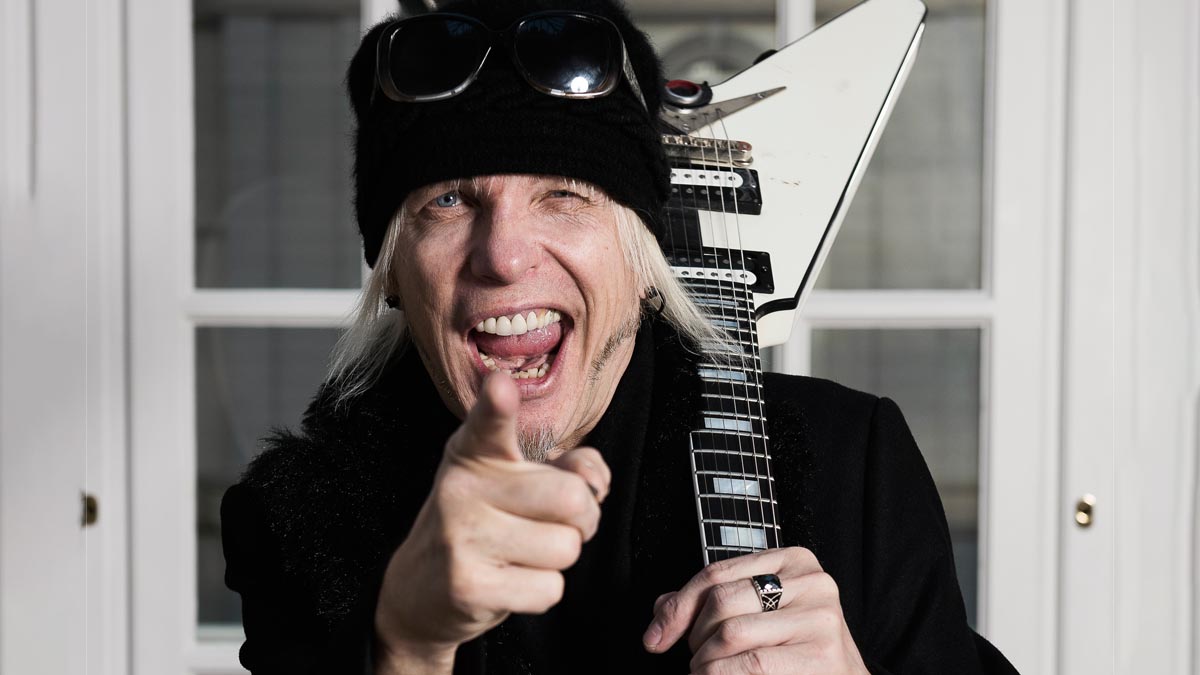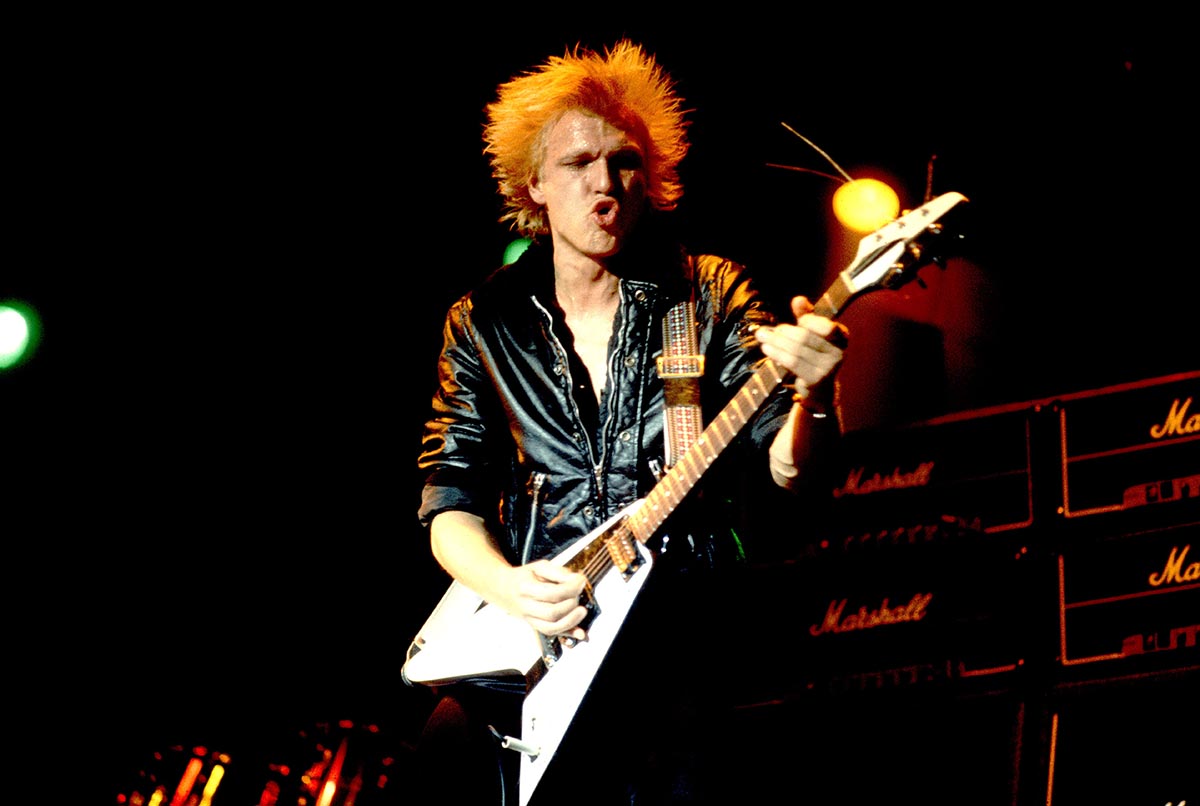Michael Schenker: “Doctor Doctor was the sound of me developing. You can hear it in the vibrato... I was always fascinated by vibrato“
As Schenker reveals the secrets of his unique style, his message is simple: “Be yourself. Don’t try to be anybody else”

Just as Eddie Van Halen was the American pioneer of shred guitar in the late 70s, so Michael Schenker was his counterpart in Europe. The German guitarist started out early – he was just 16 when he played alongside his elder brother Rudolf on the Scorpions’ debut album Lonesome Crow, released in 1972, six years before the first Van Halen album.
It was with British band UFO that Michael made his reputation as a guitar hero. But in his quest for what he calls “pure artistic expression”, he formed The Michael Schenker Group in the 80s, and has remained his own master ever since.
It was Schenker’s sense of timing, vibrato and feel that set him apart early on, and made him an inspiration for metal players such as Metallica’s Kirk Hammett, Judas Priest’s Richie Faulkner and Opeth’s Fredrik Åkesson. And now, at the age 66, Schenker’s chops are as finely tuned as ever, his new album, Immortal, full of hair-raising fretboard pyrotechnics.
“I’m an inventive person,” he tells TG as he explains how he found the right vocabulary for many a classic recording…
Develop all aspects of your technique, especially vibrato…
“On the album version of [UFO classic] Doctor Doctor, that was the sound of me developing. You can hear it in the vibrato, particularly. Back then, every day of my life felt like a tone quest!
“I started sounding more and more the way I wanted to in my head. The main thing about Doctor Doctor is that it started off as an instrumental. [UFO singer] Phil Mogg heard it and said, ‘Michael, this is great... Can you get rid of the instrumental part, leave me the rhythm chords and I can do something to it?’ So my instrumental would turn into a lead break or refreshment after each verse of chorus.
“I was always very fascinated by vibrato, so it’s something I naturally wanted to work on and improve. When we got to [1979 live album] Strangers In The Night and started touring, I was the only guitarist in the band so had to figure out how to play the harmony guitar part at the same time. I made it my mission to play both parts in one go... and I managed! Up to this day, that’s exactly how I play it.”
Get The Pick Newsletter
All the latest guitar news, interviews, lessons, reviews, deals and more, direct to your inbox!
Remember to play and discover…
“On songs like Captain Nemo, I was using a lot of open-string pull-offs. I broke a string while I was recording it, and that made me jump! I had to discover and develop something on the spot... Maybe without that broken string the song wouldn’t have happened! I like to play around.
“That’s when unusual things happen out of the blue – like my ‘Howler’ technique using a different kind of pick. I’m an inventive person. I always do things on the spot – that’s why I call guitar practice ‘play and discover’. The two go hand-in-hand. And quite often I’ll be left there thinking, ‘Wow, this is unique and different!’

Experiment with how you attack the strings...
“When I wrote Into The Arena [from The Michael Schenker Group’s first album] I was plugged into my Marshall amp trying to find new ideas. As guitar players develop, they start automatically understanding when to mute and when to open up... Because when it sounds ugly, you have to do something! It’s all about what works best in terms of how you strike the strings.
“I liked the attack from muting and then opening up for more of an ‘Arrrgh’ sound, which is more like a saw [laughs]. It all comes from practice, learning and developing. When you find sounds that you like, you start to use them more and more. It might be a technique or scale or sound, but it’s something that your ear gravitates towards. Eventually, you know exactly what to do and when to do it. Try playing an open string and changing how much you mute it... I find that is a great exercise in itself.”
Don’t feel forced to accept the sounds you don’t like...
“Originally I got a wah pedal because of Mick Ronson. Listening to what he was doing, I really heard something that I liked. The first time I tried one out, I plugged it in the wrong way and it went off like a siren (laughs). Then after plugging it in the right way, I soon discovered there was a particular frequency that was speaking to me.
“I tried to figure out a way to get that particular sound by having the wah pedal all the way down so I didn’t have to search for it in between treble and bass. I didn’t want to have to find it and then keep it in position... I’m not a technician. I knew nothing about what the wah pedal looked like inside but tried to see if there was a way of making that sound more accessible.
“I opened it up and there was a wheel, so I unscrewed it and moved the wheel – which looks like something you’d find inside a clock – and then screwed it back together. And now I had the sound I wanted, by simply clicking the wah on and keeping it always down!”
If one guitar makes you play better, why not stick with that?
“My favourite guitar is my very first Dean that was built for me. I even recorded my entire new album Immortal with it! Instead of bringing 15 or 20 guitars to the studio in order to choose from, that one was all I needed. I always use that guitar live for Rock Bottom.
“It plays very well and is more suitable for having an adventure. It has a really warm sound and for some reason I’ve been using it more and more in recent years, especially for that solo. Of course, I can play that solo on any guitar, but I’ve gotten so used to that specific guitar, so why play anything else?”
Build up legato power almost like you’re exercising at the gym...
“Quick legato is a very valuable thing to have in your arsenal, and learning how to use quick legato lines is one of the things I stumbled on early on. It doesn’t come out of nowhere perfectly, you have to keep developing it step-by-step. The more I played live, the better I got at legato. It’s a bit like exercise!
“Any time you play the guitar ends up being like exercise, so you need to put in the time to build on fretting hand fluidity. I like to loosen up my fingers before going on stage. The tendons need to be warmed up just like any sports person. You need to get loose.
“Of course, things like fast picking are also very important to be on peak level when you get out there. Make sure you do a bit of work on picking hand to get in shape. The right hand is as important as the left, after all. Every player is different and will know what they need to work on most.”
Don’t let yourself get too caught up in scales...
“You have to remember that music is basically a language. Different players have different accents. For example, in a lot of Spanish music, they go from the E major chord to the F major chord. But I don’t work like that. I break out of things before they become a pattern. It’s a personal expression of how I feel and what I want to do right there and then.
“It’s never based on any structure. Once a person repeats a scale too often, especially one that already exists going all the way back to Mozart and those guys, the more you become that scale. The longer you do it, the deeper the groove and the less chance you have of breaking out of it.”
Ask yourself how to find the notes that please you...
“If your note choices end up pleasing anyone else, that’s the icing on the cake, but always start with you. When I taught guitar, I used to tell people to sing something from the heart and make that their scale – at least for that moment in time. Then you have a scale that nobody else has played and if you keep repeating it, people will still find it original.
“My favourite way of creating is finding three simple notes that could create goose pimples. That’s always been my fascination. So if you feel like you have to play scales, make sure they are your own and not someone else’s. Make your own melodies from inside your head, that way it’s not something that someone else has already done a million times. Be yourself, don’t try to be anybody else.”
You’ll know when you’ve found your signature tone...
“Here’s a weird story for you. My main amp that I used in UFO broke down in 1983 while I was in America, it came back from the repair place and I think they’d stolen everything out of it. What I got back was a completely different amplifier that was unusable. I had to start from scratch and find something.
“I looked at 20 or 30 different types of amps and ended up with a JCM800. Some guy in New York told me that I actually designed that particular amplifier and I said, ‘You must be joking!’ But then I remembered in 1980, I was invited by Jim Marshall to go to the factory and design a Michael Schenker signature. It was never completed.
“Those papers had been lying around, stored somewhere. At some point later, someone found it and they must have decided to make that amplifier. The strangest thing is that I chose the amplifier without knowing! It was my sound. Remember that deep down inside you must also have your own sound, too.”'
- Michael Schenker Group's new album, Immortal, is out now via Nuclear Blast.
Amit has been writing for titles like Total Guitar, MusicRadar and Guitar World for over a decade and counts Richie Kotzen, Guthrie Govan and Jeff Beck among his primary influences as a guitar player. He's worked for magazines like Kerrang!, Metal Hammer, Classic Rock, Prog, Record Collector, Planet Rock, Rhythm and Bass Player, as well as newspapers like Metro and The Independent, interviewing everyone from Ozzy Osbourne and Lemmy to Slash and Jimmy Page, and once even traded solos with a member of Slayer on a track released internationally. As a session guitarist, he's played alongside members of Judas Priest and Uriah Heep in London ensemble Metalworks, as well as handled lead guitars for legends like Glen Matlock (Sex Pistols, The Faces) and Stu Hamm (Steve Vai, Joe Satriani, G3).







![[from left] George Harrison with his Gretsch Country Gentleman, Norman Harris of Norman's Rare Guitars holds a gold-top Les Paul, John Fogerty with his legendary 1969 Rickenbacker](https://cdn.mos.cms.futurecdn.net/TuH3nuhn9etqjdn5sy4ntW.jpg)





